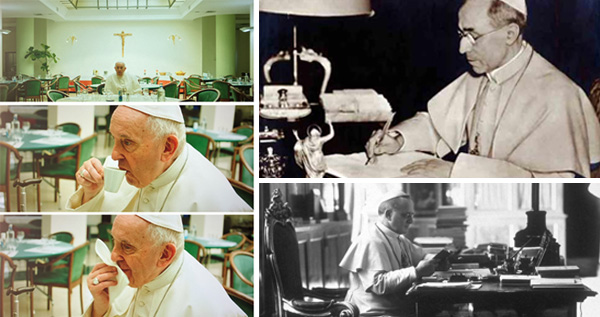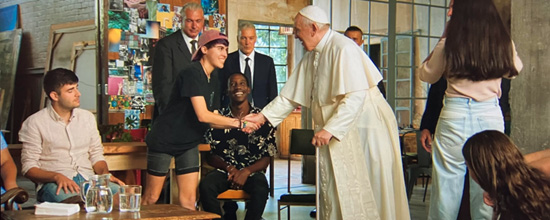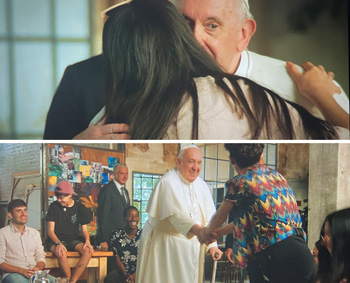Faith under Attack
 |
 |
 |
 |
 |
 |
 |
Movie Review on ‘The Pope Answers’ - Part II
Revolutionary Ambiences & Gestures
The previous article gave an overview of some of the most scandalous parts of the film The Pope: Answers, a Disney+ film that was released in Holy Week earlier this year and catered to Hispanic youth. The film shows a casual interview between the Pope and Spanish-speaking young people from different countries.
Now, I would like to comment on the egalitarian, vulgar and miserablist ambience and customs present in this film, and how it is a clear departure from the solemn ceremonial past of the Papacy that has always characterized the Church until the progressivist takeover at Vatican II.
The Pope’s ‘home’ ambience – Casa Santa Marta
In the beginning of the film, we see Pope Francis in Casa Santa Marta, seated in an empty room, solitary and alone in a geriatric-type ambience, where his only companions are the few staff and guards. The refectory is a room with few decorations, a modernist crucifix, simple tables and chairs that could serve for the employees of the building, but never for a Pope.
“The coffee is very good here – have some cookies” the Pope invites one of the staff, as he sips coffee from a cheap white demi-tasse without any ornament. The camera closes in on him, showing him inelegantly wiping his mouth with a napkin.
The egalitarian & minimalist architecture, decor and layout of this refectory along with the casual demeanor of Pope Francis makes a poor impression on the viewer. Compare that with the solemn regal papal ambiences of the past and the composed, venerable demeanor of the pre-Vatican II Popes, who sat in imposing special chairs and maintained a solemn expression and erect posture, even for common tasks...
 A miserablist ‘co-working space’
A miserablist ‘co-working space’

 Next, the viewer sees Francis driven to a communal “co-working space” 20 minutes away from the Vatican. To arrive at this meeting place he enters a dirty elevator with its depressing green painting peeling off. He enters a large barren room, painted with unmatching colors, having two large windows for walls.
Next, the viewer sees Francis driven to a communal “co-working space” 20 minutes away from the Vatican. To arrive at this meeting place he enters a dirty elevator with its depressing green painting peeling off. He enters a large barren room, painted with unmatching colors, having two large windows for walls.
The only dignified piece of furniture is a yellow chair – perhaps it was brought from the Vatican. The walls show distressed cement. Two hand sculptures set on the top left and bottom right of a short bookshelf, books haphazardly recline on the shelf begging for a bookend, a pile of magazines lies half-in half-out of the shelf... This is a communist-tribal work room certainly not fit for an interview of youth with the Vicar of Christ.
Vulgar behavior & language
The young people wait for the Pope and casually chat. The lack of modesty and decorum seen in the guests of the Pope is shocking: mini skirts, short shorts, bare midriffs, ultra-low necklines, a spaghetti strap top that exposes the bosom... One woman sits cross-legged on a table, others display their tattoos on their bare legs and arms. The viewers hear some of the remarks of the youth before the Pope arrives:
Juan, a Spanish young man who was abused as a child at the hands of an Opus Dei member, says: “This Pope, I think he is someone more...” “...Liberal,” adds one of the young women, Milagros, an Argentinian abortion activist.
Juan responds: “Yes, but on the other hand, cassocks, no... ” He waves his hands in the air as if to indicate Pope Francis’ disapproval, while the others laugh.
Celia, a lesbian with purple hair who identifies as non-binary, affirms: “Well this pope is more campechano [colloquial word for a person with aversion to ceremony], he doesn’t like too much pomp around him, all the protocols... mm-mm…, he doesn’t like it.” Later, Lucía, another lesbian and ex-nun (unclear whether she was a novice or professed), asks the others: “Will there be a time for selfies with the pope?”
So, even before he appears, Francis is presented as an easy-going, laid-back, casual and vulgar person. The pre-meeting talk lowers the papacy to the level of a common person of the street.
 When Francis enters there is silence. He jokingly asks: “Silence – who died?”
When Francis enters there is silence. He jokingly asks: “Silence – who died?”
“How are you doing?” Francis continues as he walks in with his cane. “You’re not 50 years old, you’re not moving! I came to talk with young people.”
Addressing the abortion activist Milagros, he asks her: ”Como te va?” (“How is it going?”) This is shocking: Instead of greeting the youth with dignity and authority, the Pope addresses them as equals. In itself this is a revolution in customs for the papacy, which always followed protocol and formality.
 Milagros responds: “Can I give you a kiss? Two?” “Yes!” Francis responds. They kiss each other on the cheek. Then the Pope remarks: “Two [kisses will cost you] 50 pesos.” This joke is particularly inconvenient since it implies the Pope is selling kisses…
Milagros responds: “Can I give you a kiss? Two?” “Yes!” Francis responds. They kiss each other on the cheek. Then the Pope remarks: “Two [kisses will cost you] 50 pesos.” This joke is particularly inconvenient since it implies the Pope is selling kisses…
Francis then goes on to greet the others, shaking hands or kissing them. He also casually shook the hand of Alejandra, the Colombian porn actress wearing the spaghetti strap blouse.
He tells them: “You are too disciplined! Son la piel de Judas! Preparesé!” This last phrase is another Spanish colloquialism, equivalent to “You all are being rascals, get ready for the interview.”
Alejandra asks: “How’s your knee?” Francis responds: “It’s bothersome.” He could have given a more appropriate answer, such as: “It is a suffering, but to suffer is follow the Cross of Christ...” Another missed opportunity to speak a little of Our Lord. Is not Francis His Vicar?
He asks: “So the program was for you to come to talk to the Pope. Isn’t it boring to talk to a priest?” The youth are visibly uncomfortable and unimpressed at the attempted quip. They respond with some chuckles only to not make him feel embarrassed. “Pelota al centro, empieza el partido!” He makes a soccer reference: “Ball is in the center, the match has begun!”
Milagros asks: “How should we start? Who goes first?” Francis interjects: “Quien es el más caradura?” [“Who is the most shameless?”] The Pope, encouraging the youth to act shamelessly...
Leaving the youth with a bad taste
Before Vatican II, although the Revolution was already present in society and Progressivism in the Church, there was still a ceremony and strict protocol that had to be followed in an audience with the Pope. Besides the requirements of proper dress and expectations of polite etiquette, visitors most certainly addressed the Pope as “Your Holiness” and would not dare to address him with an informal “You,” especially not the informal second person tu in Spanish.
Francis has certainly outdone all of his predecessors in introducing papal manners that frontally oppose the ceremony of the past – “Call me Jorge” being a poignant example of this. This film seems to be a landmark in Francis’ revolution in customs.
The movie’s ending scenes show the youth in their daily lives, accompanied by a nightclub-style song Le rezo a Maria (I pray to Mary), written by Ben Carrillo.
Carrillo, a Guatemalan hip-hop artist based in Los Angeles, has written profanity-laden songs about prostitutes, marijuana “trips” on the beach and fornication with women. This is the profile of the artist whose music was chosen to accompany an interview with the Vicar of Christ.
The closing scenes of The Pope: Answers show the youth in their daily lives: Juan and friends in swim trunks at a nighttime pool party, Lucía and Celia with their respective lesbian lovers, Dora praying in a Protestant service, Alejandra the pornographer-prostitute smiling & feeding her fish in a barely lit room... while the song repeats over and over: “Amen, Amen.”
The strong impression that one is left with is this: Pope Francis’ message to the youth is “Amen. Yes to following bad paths, yes to error and immorality... Amen, Amen.”
It is clear that the makers of this film were striving to present a provocatively permissive ambience, blatantly contradicting past Church protocols and ceremonial ambiences. All of this was with the full approval of Pope Francis & with the support of the official Vatican media.
Continued

Now, I would like to comment on the egalitarian, vulgar and miserablist ambience and customs present in this film, and how it is a clear departure from the solemn ceremonial past of the Papacy that has always characterized the Church until the progressivist takeover at Vatican II.
The Pope’s ‘home’ ambience – Casa Santa Marta
In the beginning of the film, we see Pope Francis in Casa Santa Marta, seated in an empty room, solitary and alone in a geriatric-type ambience, where his only companions are the few staff and guards. The refectory is a room with few decorations, a modernist crucifix, simple tables and chairs that could serve for the employees of the building, but never for a Pope.
“The coffee is very good here – have some cookies” the Pope invites one of the staff, as he sips coffee from a cheap white demi-tasse without any ornament. The camera closes in on him, showing him inelegantly wiping his mouth with a napkin.
The egalitarian & minimalist architecture, decor and layout of this refectory along with the casual demeanor of Pope Francis makes a poor impression on the viewer. Compare that with the solemn regal papal ambiences of the past and the composed, venerable demeanor of the pre-Vatican II Popes, who sat in imposing special chairs and maintained a solemn expression and erect posture, even for common tasks...

Francis at left: A geriatric ambience & vulgar demeanor:
At right top, Pius XII, & bottom, Pius XI: elevated ambience, solemn & serious demeanor

Francis being escorted up the creepy, poorly-lit, dirty elevator; below, no pomp, no elevation in a hippie-tribal work room in the ‘peripheries’

The only dignified piece of furniture is a yellow chair – perhaps it was brought from the Vatican. The walls show distressed cement. Two hand sculptures set on the top left and bottom right of a short bookshelf, books haphazardly recline on the shelf begging for a bookend, a pile of magazines lies half-in half-out of the shelf... This is a communist-tribal work room certainly not fit for an interview of youth with the Vicar of Christ.
Vulgar behavior & language
The young people wait for the Pope and casually chat. The lack of modesty and decorum seen in the guests of the Pope is shocking: mini skirts, short shorts, bare midriffs, ultra-low necklines, a spaghetti strap top that exposes the bosom... One woman sits cross-legged on a table, others display their tattoos on their bare legs and arms. The viewers hear some of the remarks of the youth before the Pope arrives:
Juan, a Spanish young man who was abused as a child at the hands of an Opus Dei member, says: “This Pope, I think he is someone more...” “...Liberal,” adds one of the young women, Milagros, an Argentinian abortion activist.
Juan responds: “Yes, but on the other hand, cassocks, no... ” He waves his hands in the air as if to indicate Pope Francis’ disapproval, while the others laugh.
Celia, a lesbian with purple hair who identifies as non-binary, affirms: “Well this pope is more campechano [colloquial word for a person with aversion to ceremony], he doesn’t like too much pomp around him, all the protocols... mm-mm…, he doesn’t like it.” Later, Lucía, another lesbian and ex-nun (unclear whether she was a novice or professed), asks the others: “Will there be a time for selfies with the pope?”
So, even before he appears, Francis is presented as an easy-going, laid-back, casual and vulgar person. The pre-meeting talk lowers the papacy to the level of a common person of the street.

Pope Francis greets the youth in an egalitarian way
“How are you doing?” Francis continues as he walks in with his cane. “You’re not 50 years old, you’re not moving! I came to talk with young people.”
Addressing the abortion activist Milagros, he asks her: ”Como te va?” (“How is it going?”) This is shocking: Instead of greeting the youth with dignity and authority, the Pope addresses them as equals. In itself this is a revolution in customs for the papacy, which always followed protocol and formality.

"Two kisses will cost you fifty pesos"
Francis then goes on to greet the others, shaking hands or kissing them. He also casually shook the hand of Alejandra, the Colombian porn actress wearing the spaghetti strap blouse.
He tells them: “You are too disciplined! Son la piel de Judas! Preparesé!” This last phrase is another Spanish colloquialism, equivalent to “You all are being rascals, get ready for the interview.”
Alejandra asks: “How’s your knee?” Francis responds: “It’s bothersome.” He could have given a more appropriate answer, such as: “It is a suffering, but to suffer is follow the Cross of Christ...” Another missed opportunity to speak a little of Our Lord. Is not Francis His Vicar?
He asks: “So the program was for you to come to talk to the Pope. Isn’t it boring to talk to a priest?” The youth are visibly uncomfortable and unimpressed at the attempted quip. They respond with some chuckles only to not make him feel embarrassed. “Pelota al centro, empieza el partido!” He makes a soccer reference: “Ball is in the center, the match has begun!”
Milagros asks: “How should we start? Who goes first?” Francis interjects: “Quien es el más caradura?” [“Who is the most shameless?”] The Pope, encouraging the youth to act shamelessly...
Leaving the youth with a bad taste
Before Vatican II, although the Revolution was already present in society and Progressivism in the Church, there was still a ceremony and strict protocol that had to be followed in an audience with the Pope. Besides the requirements of proper dress and expectations of polite etiquette, visitors most certainly addressed the Pope as “Your Holiness” and would not dare to address him with an informal “You,” especially not the informal second person tu in Spanish.
Francis has certainly outdone all of his predecessors in introducing papal manners that frontally oppose the ceremony of the past – “Call me Jorge” being a poignant example of this. This film seems to be a landmark in Francis’ revolution in customs.
The movie’s ending scenes show the youth in their daily lives, accompanied by a nightclub-style song Le rezo a Maria (I pray to Mary), written by Ben Carrillo.
Carrillo, a Guatemalan hip-hop artist based in Los Angeles, has written profanity-laden songs about prostitutes, marijuana “trips” on the beach and fornication with women. This is the profile of the artist whose music was chosen to accompany an interview with the Vicar of Christ.
The closing scenes of The Pope: Answers show the youth in their daily lives: Juan and friends in swim trunks at a nighttime pool party, Lucía and Celia with their respective lesbian lovers, Dora praying in a Protestant service, Alejandra the pornographer-prostitute smiling & feeding her fish in a barely lit room... while the song repeats over and over: “Amen, Amen.”
The strong impression that one is left with is this: Pope Francis’ message to the youth is “Amen. Yes to following bad paths, yes to error and immorality... Amen, Amen.”
It is clear that the makers of this film were striving to present a provocatively permissive ambience, blatantly contradicting past Church protocols and ceremonial ambiences. All of this was with the full approval of Pope Francis & with the support of the official Vatican media.
Continued

Posted July 10, 2023
______________________
______________________





